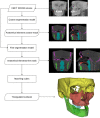AI-based automatic segmentation of craniomaxillofacial anatomy from CBCT scans for automatic detection of pharyngeal airway evaluations in OSA patients
- PMID: 35831451
- PMCID: PMC9279304
- DOI: 10.1038/s41598-022-15920-1
AI-based automatic segmentation of craniomaxillofacial anatomy from CBCT scans for automatic detection of pharyngeal airway evaluations in OSA patients
Abstract
This study aims to generate and also validate an automatic detection algorithm for pharyngeal airway on CBCT data using an AI software (Diagnocat) which will procure a measurement method. The second aim is to validate the newly developed artificial intelligence system in comparison to commercially available software for 3D CBCT evaluation. A Convolutional Neural Network-based machine learning algorithm was used for the segmentation of the pharyngeal airways in OSA and non-OSA patients. Radiologists used semi-automatic software to manually determine the airway and their measurements were compared with the AI. OSA patients were classified as minimal, mild, moderate, and severe groups, and the mean airway volumes of the groups were compared. The narrowest points of the airway (mm), the field of the airway (mm2), and volume of the airway (cc) of both OSA and non-OSA patients were also compared. There was no statistically significant difference between the manual technique and Diagnocat measurements in all groups (p > 0.05). Inter-class correlation coefficients were 0.954 for manual and automatic segmentation, 0.956 for Diagnocat and automatic segmentation, 0.972 for Diagnocat and manual segmentation. Although there was no statistically significant difference in total airway volume measurements between the manual measurements, automatic measurements, and DC measurements in non-OSA and OSA patients, we evaluated the output images to understand why the mean value for the total airway was higher in DC measurement. It was seen that the DC algorithm also measures the epiglottis volume and the posterior nasal aperture volume due to the low soft-tissue contrast in CBCT images and that leads to higher values in airway volume measurement.
© 2022. The Author(s).
Conflict of interest statement
Financial support was received by Diagnocat Co. Ltd., San Francisco CA. Matvey Ezhov, Maxim Gusarev, Alexander Plaksin, Mamat Shamshiev, Maria Golitsyna, Eugene Shumilov, and Alex Sanders are employees of Diagnocat Co. Ltd. Kaan Orhan is a scientific research advisor for the Diagnocat Co. Ltd., Aida Kurbanova, Melis Misirli, Gürkan Ünsal, Secil Aksoy, Finn Rasmussen have no potential competing interests.
Similar articles
-
A deep learning algorithm proposal to automatic pharyngeal airway detection and segmentation on CBCT images.Orthod Craniofac Res. 2021 Dec;24 Suppl 2:117-123. doi: 10.1111/ocr.12480. Epub 2021 Mar 8. Orthod Craniofac Res. 2021. PMID: 33619828
-
Fully automatic segmentation of sinonasal cavity and pharyngeal airway based on convolutional neural networks.Am J Orthod Dentofacial Orthop. 2021 Jun;159(6):824-835.e1. doi: 10.1016/j.ajodo.2020.05.017. Am J Orthod Dentofacial Orthop. 2021. PMID: 34059213
-
Subregional pharyngeal changes after orthognathic surgery in skeletal Class III patients analyzed by convolutional neural networks-based segmentation.J Dent. 2023 Aug;135:104565. doi: 10.1016/j.jdent.2023.104565. Epub 2023 Jun 10. J Dent. 2023. PMID: 37308053
-
Are multi-detector computed tomography and cone-beam computed tomography exams and software accurate to measure the upper airway? A systematic review.Eur J Orthod. 2023 Nov 30;45(6):818-831. doi: 10.1093/ejo/cjad060. Eur J Orthod. 2023. PMID: 37797294
-
Reliability of upper pharyngeal airway assessment using dental CBCT: a systematic review.Eur J Orthod. 2017 Oct 1;39(5):489-496. doi: 10.1093/ejo/cjw079. Eur J Orthod. 2017. PMID: 27999121
Cited by
-
Performance enhancement of deep learning based solutions for pharyngeal airway space segmentation on MRI scans.Sci Rep. 2024 Aug 24;14(1):19671. doi: 10.1038/s41598-024-70826-4. Sci Rep. 2024. PMID: 39181978 Free PMC article.
-
Concerns regarding deployment of AI-based applications in dentistry - a review.BDJ Open. 2025 Mar 25;11(1):27. doi: 10.1038/s41405-025-00319-7. BDJ Open. 2025. PMID: 40133287 Free PMC article. Review.
-
Do patients with different craniofacial patterns have differences in upper airway volume? A systematic review with network meta-analysis.Eur J Orthod. 2024 Apr 1;46(2):cjae010. doi: 10.1093/ejo/cjae010. Eur J Orthod. 2024. PMID: 38526866 Free PMC article.
-
Artificial Intelligence as an Aid in CBCT Airway Analysis: A Systematic Review.Life (Basel). 2022 Nov 15;12(11):1894. doi: 10.3390/life12111894. Life (Basel). 2022. PMID: 36431029 Free PMC article. Review.
-
A novel difficult-to-segment samples focusing network for oral CBCT image segmentation.Sci Rep. 2024 Mar 1;14(1):5068. doi: 10.1038/s41598-024-55522-7. Sci Rep. 2024. PMID: 38429362 Free PMC article.
References
MeSH terms
LinkOut - more resources
Full Text Sources


